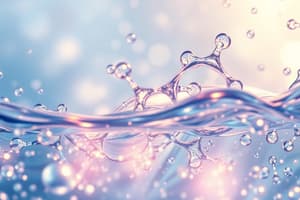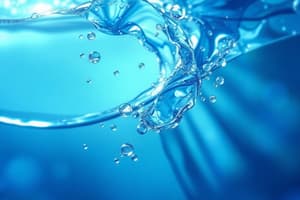Podcast
Questions and Answers
What aspects of water's molecular structure directly contribute to its polarity?
What aspects of water's molecular structure directly contribute to its polarity?
- The presence of only covalent bonds within the molecule.
- The V-shape and the higher electronegativity of the oxygen atom. (correct)
- The linear arrangement of hydrogen and oxygen atoms.
- The equal sharing of electrons between hydrogen and oxygen atoms.
How does the high specific heat capacity of water contribute to the phenomenon of evaporative cooling in living organisms?
How does the high specific heat capacity of water contribute to the phenomenon of evaporative cooling in living organisms?
- It requires a large amount of energy for water to transition from liquid to gas, absorbing substantial heat from the organism's surface. (correct)
- It allows water to absorb a small amount of heat when it evaporates, thus efficiently cooling the organism.
- It prevents water from freezing, ensuring a constant cooling effect.
- It speeds up the rate of water evaporation, quickly dispelling heat.
Which of the following scenarios best illustrates the combined action of both cohesion and adhesion?
Which of the following scenarios best illustrates the combined action of both cohesion and adhesion?
- Sweat evaporating from the skin cools the body.
- A paper towel absorbs a water spill. (correct)
- A water strider effortlessly glides across the surface of a pond.
- Water forms a droplet on a waxy leaf.
Under what circumstances would the property of surface tension be most significantly reduced in a body of water?
Under what circumstances would the property of surface tension be most significantly reduced in a body of water?
How does water's role as a solvent contribute to its ability to maintain homeostasis in living organisms?
How does water's role as a solvent contribute to its ability to maintain homeostasis in living organisms?
What implications does water's density anomaly (being less dense as a solid) have for aquatic ecosystems in cold climates?
What implications does water's density anomaly (being less dense as a solid) have for aquatic ecosystems in cold climates?
Given that water molecules can form up to four hydrogen bonds, how does this capability influence water's boiling point?
Given that water molecules can form up to four hydrogen bonds, how does this capability influence water's boiling point?
How does the polarity of water molecules contribute to the formation of hydration spheres around ions in solution?
How does the polarity of water molecules contribute to the formation of hydration spheres around ions in solution?
Why is capillary action essential for the survival of tall trees, especially in the context of water transport against gravity?
Why is capillary action essential for the survival of tall trees, especially in the context of water transport against gravity?
How does water's high heat of vaporization impact climate regulation on a global scale?
How does water's high heat of vaporization impact climate regulation on a global scale?
How does the capacity of water to form hydrogen bonds directly impact its ability to dissolve a wide range of chemical compounds?
How does the capacity of water to form hydrogen bonds directly impact its ability to dissolve a wide range of chemical compounds?
What is the key distinction between cohesion and adhesion in the context of water's properties, and how do these relate to capillary action?
What is the key distinction between cohesion and adhesion in the context of water's properties, and how do these relate to capillary action?
If a mutation occurred that disrupted the polarity of water molecules, which of the following consequences would most significantly impact living systems?
If a mutation occurred that disrupted the polarity of water molecules, which of the following consequences would most significantly impact living systems?
How does water's unique ability to moderate temperature extremes directly benefit terrestrial and aquatic organisms?
How does water's unique ability to moderate temperature extremes directly benefit terrestrial and aquatic organisms?
Considering water's properties, how does its role in the context of plant transpiration directly influence weather patterns?
Considering water's properties, how does its role in the context of plant transpiration directly influence weather patterns?
In what way does the principle of adhesion specifically aid in the process of nutrient delivery from the roots to the leaves in vascular plants?
In what way does the principle of adhesion specifically aid in the process of nutrient delivery from the roots to the leaves in vascular plants?
What is the primary reason for the relatively high surface tension observed in water, and how does this surface tension affect small aquatic organisms?
What is the primary reason for the relatively high surface tension observed in water, and how does this surface tension affect small aquatic organisms?
How does the high specific heat of water affect large-scale ocean currents, and what are the climatic implications?
How does the high specific heat of water affect large-scale ocean currents, and what are the climatic implications?
How would compromising the hydrogen bonds in water impact its colligative properties, specifically freezing point depression and boiling point elevation?
How would compromising the hydrogen bonds in water impact its colligative properties, specifically freezing point depression and boiling point elevation?
Water's ability to act as a versatile solvent is crucial in drug delivery systems. How does this property facilitate targeted drug release in the human body?
Water's ability to act as a versatile solvent is crucial in drug delivery systems. How does this property facilitate targeted drug release in the human body?
How does the high latent heat of fusion of water relate to the survival of aquatic organisms in freezing temperatures?
How does the high latent heat of fusion of water relate to the survival of aquatic organisms in freezing temperatures?
How are the cohesive properties of water utilized in industrial processes such as the manufacturing of cosmetics and pharmaceuticals?
How are the cohesive properties of water utilized in industrial processes such as the manufacturing of cosmetics and pharmaceuticals?
If nonpolar molecules disrupt hydrogen bonding in water, how is the hydrophobic effect thermodynamically driven?
If nonpolar molecules disrupt hydrogen bonding in water, how is the hydrophobic effect thermodynamically driven?
Several plant adaptations enhance capillary action. How does increased xylem vessel diameter in certain plants affect water transport efficiency?
Several plant adaptations enhance capillary action. How does increased xylem vessel diameter in certain plants affect water transport efficiency?
How do detergents reduce water's surface tension, and what are the environmental implications?
How do detergents reduce water's surface tension, and what are the environmental implications?
The process of marine snow formation involves the aggregation of organic matter in seawater. How does water's solvent property influence the distribution and decomposition of marine snow?
The process of marine snow formation involves the aggregation of organic matter in seawater. How does water's solvent property influence the distribution and decomposition of marine snow?
How does water's unique heat-related properties play a protective role during geyser eruptions?
How does water's unique heat-related properties play a protective role during geyser eruptions?
Dehydration stress can induce stomatal closure in plants. How is this response connected to water's cohesive and adhesive properties?
Dehydration stress can induce stomatal closure in plants. How is this response connected to water's cohesive and adhesive properties?
How does water's high surface tension combine with other factors to influence droplet formation during cloud condensation?
How does water's high surface tension combine with other factors to influence droplet formation during cloud condensation?
Water's high specific heat is pivotal in managing the cooling systems of nuclear reactors. Choose the reason.
Water's high specific heat is pivotal in managing the cooling systems of nuclear reactors. Choose the reason.
How does water facilitate the self-assembly of amphiphilic molecules into micelles? Consider both polarity.
How does water facilitate the self-assembly of amphiphilic molecules into micelles? Consider both polarity.
Consider water's role in moderating earth. What properties enable lakes to act as thermal buffers?
Consider water's role in moderating earth. What properties enable lakes to act as thermal buffers?
What might happen during a drought to water's natural properties?
What might happen during a drought to water's natural properties?
In high altitude, how does the decrease in air pressure affect water's boiling point, and what implications does this have for cooking?
In high altitude, how does the decrease in air pressure affect water's boiling point, and what implications does this have for cooking?
How does the formation of clathrate hydrates in deep sea environments depend on temperature, pressure, and water's properties?
How does the formation of clathrate hydrates in deep sea environments depend on temperature, pressure, and water's properties?
Flashcards
What is a polar molecule?
What is a polar molecule?
A molecule with uneven charge distribution, resulting in partial positive and negative ends.
What is the shape of a water molecule?
What is the shape of a water molecule?
The V-shaped structure with one oxygen atom and two hydrogen atoms.
What are hydrogen bonds?
What are hydrogen bonds?
The attraction between oppositely charged regions of water molecules.
What is cohesion?
What is cohesion?
Signup and view all the flashcards
What is adhesion?
What is adhesion?
Signup and view all the flashcards
What is surface tension?
What is surface tension?
Signup and view all the flashcards
What is capillary action?
What is capillary action?
Signup and view all the flashcards
What is specific heat capacity?
What is specific heat capacity?
Signup and view all the flashcards
What role does water play in homeostasis?
What role does water play in homeostasis?
Signup and view all the flashcards
Study Notes
Water Molecule Structure
- Water (H2O) has a V-shape consisting of one oxygen atom and two hydrogen atoms.
- The oxygen atom is more electronegative which means it attracts electrons more strongly than hydrogen.
Polarity of Water
- Water is a polar molecule due to unequal electron sharing between oxygen and hydrogen.
- Oxygen has a partial negative charge and hydrogen atoms have a partial positive charge.
Hydrogen Bonds
- Oppositely charged regions of water molecules attract to form hydrogen bonds.
- A single water molecule can form up to four hydrogen bonds at a time.
Cohesion of Water
- Cohesion is the tendency of water molecules to stick together due to hydrogen bonds.
- Insects can walk on water due to cohesion.
Adhesion of Water
- Adhesion is the tendency of water to stick to other polar surfaces.
- Adhesion allows water to form beads on surfaces such as leaves.
Surface Tension
- Surface tension is a result of cohesion, creating a "skin" on the water's surface.
- This allows small objects to float and insects to walk on water.
Capillary Action
- Capillary action occurs when water moves through narrow spaces without external forces.
- This is crucial for water transport in plants.
Specific Heat Capacity
- Water has a high specific heat capacity, absorbing a lot of heat without changing temperature.
- This quality helps regulate temperature in living organisms.
Water's Role in Homeostasis
- Water helps maintain stable internal conditions because of its properties.
- Water regulates temperature and transports nutrients.
Unique Properties Summary
- The structure and polarity of water lead to hydrogen bonding.
- Hydrogen bonding results in high specific heat, cohesion, adhesion, surface tension, and capillary action.
Water Property Experiments: Materials Needed
- Droppers
- Pennies
- Paperclips
- White flowers (e.g., carnations) or paper towels
- Food coloring
- Ice cubes
- Beakers or glasses of water
Water Property Experiments: Process Questions
- How many drops of water were you able to fit on the penny before it spilled over?
- What does the formation of a water dome on the penny tell you about water molecules?
- How does the floating paperclip demonstrate the concept of surface tension?
- What did you observe when the white flower or paper towel was placed in colored water, and what does this tell you about capillary action?
- Why do you think the ice cubes float in water, and how is this related to the density of ice compared to liquid water?
Water and Environmental Stewardship Essay
- Research and write a short essay on how the unique properties of water contribute to environmental stewardship and sustainability.
- Discuss how understanding water’s properties can help in solving environmental challenges such as water conservation, pollution, and climate change.
- Reflect on the importance of responsible water use and how individuals can contribute to water conservation efforts.
Studying That Suits You
Use AI to generate personalized quizzes and flashcards to suit your learning preferences.



